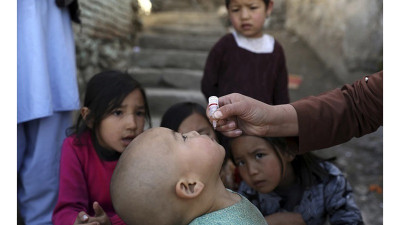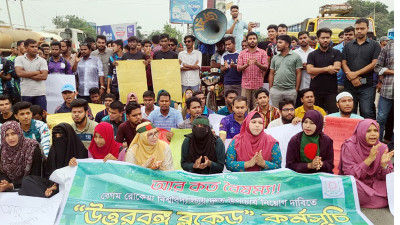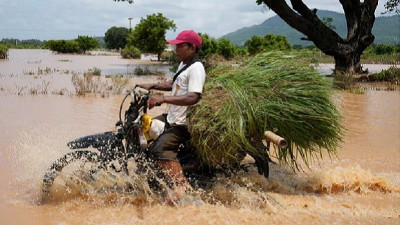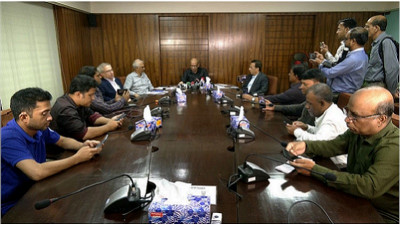 Photo: Collected
Photo: Collected The years 2007 and 2008 were eventful in the country's
history, and 2009 also became significant due to the Pilkhana massacre. During
this period, General (Ret.) Moeen U Ahmed was the head of the country's army.
He served in this position from June 15, 2005, for four years. Finally, he has
broken his silence on the Pilkhana massacre issue. He made these statements
from Florida, USA, and shared them on his YouTube channel on Thursday. Here is
a summary for the readers:
I will briefly describe what happened at Pilkhana that
day, why 74 people, including 57 officers, were killed, and what role the army
played.
At 7.30 am on February 25, the usual work began at the
army headquarters. That day, there was a GSPC (General Staff Procurement
Committee) meeting where the army would decide on procurement plans for the
upcoming year. The army chief chaired the meeting attended by the PSOs,
designated directors, and relevant senior officers. I have been preparing to
attend this GSPC meeting since early morning. Around 8.45 am, CGS Lieutenant
General Ibn Jamali came to my office and said we had some 81mm mortar shells
that the army does not use. Their storage and maintenance were becoming
challenging for us. However, the BDR (Border Guards Bangladesh) uses 81mm
mortar shells. He suggested it would be beneficial if I spoke to the BDR
Director General and if they took the shells. Recognizing the importance of the
proposal, I asked ADC Captain Junaid to connect me with the DG BDR, which he
did. After exchanging greetings, I spoke with BDR DG General Shakil Ahmed and
proposed the transfer of the 81mm mortars. Before ending the conversation, he
gladly accepted and praised the previous day's annual parade. During the
discussion, he seemed to have high morale. I believe he was unaware of the
rebels' plans. If he had known, he would undoubtedly have informed me. At 8.58
am, CGS and I headed to the conference room for the GSPC meeting. General
Shakil might have left his office simultaneously to attend the Central Darbar.
The GSPC meeting began at 9.00 am, and we became busy with procurement matters.
Around 9.30 am, my Principal Secretary, Colonel Firoz, entered the meeting room
and informed me that there was trouble at Pilkhana and that my guidance was
needed.
I thought, "I just spoke with the BDR Director
General; what could have happened suddenly?" Nonetheless, I postponed the
meeting and went to my office with the CGS and the Director of Military
Operations. I instructed ADC Captain Junaid to connect me with General Shakil
and the former Prime Minister. Their phones were constantly busy, and
connecting immediately was impossible. In the meantime, information about
Pilkhana began to come through military intelligence, and I was informed about
what was happening at Pilkhana. Realizing the severity of the situation, I
ordered the 46 Independent Infantry Brigade to prepare for operations without
waiting for further instructions. They began immediate preparations, which were
named Operation Restore Order. I informed PSO-FD General Mabin about the
actions taken. At 9.47 am, I got through to the BDR Director General on the
phone and asked him what had happened.
He provided me with a brief overview of a dire situation.
He said that during the Darbar, two armed soldiers entered the hall; one stood
behind me and fainted, while the other left the hall and went outside. Shortly
after, gunshots were heard from outside. Upon hearing the gunfire, the soldiers
present in the Darbar started causing chaos and exited the hall. It appeared
that everything was planned, and the plan was being executed accordingly. He
also mentioned that he had sent sector commanders and battalion commanders to
bring them back so the Darbar could resume. He hoped that the Darbar could
start again soon.
I informed him that I had ordered the 46 Independent
Infantry Brigade to prepare to handle the situation and that they would soon
set out for Pilkhana.
Many believe the BDR Director General called me (the
Chief of Army Staff) for help. This is not true. I called the Director General
and informed him about the measures we were taking, but he did not call me.
At 9.54 am, I managed to reach the former PM on mobile.
By then, she had received much information about the BDR uprising. I informed
her that I had instructed the 46 Independent Infantry Brigade to prepare. She
inquired how long it would take to get the Brigade ready. I told her that it
typically takes 6 hours, but we could accelerate it to 2 hours. She agreed when
asked if she could give the order for the Brigade to head to Pilkhana. Before
the order, the Brigade was engaged in routine training. Weapons and ammunition
were in magazines, military vehicles were in the garage, and wireless and other
equipment were in stores. It required time to assemble everything and set up
the command structure. However, the 46 Brigade was ready and set out within an
hour, thanks to Brigade Commander Brigadier General Hakim's strong leadership
and unit commanders. Under the Brigade Commander's leadership, 10 officers and
655 soldiers began their journey to Pilkhana.
At 10.30 am, the advance units of the Brigade crossed the
Jahangir Gate. The fact that they prepared and set out quickly is an example of
a rare achievement. Meanwhile, the rebels deployed heavy machine guns, mortars,
rocket launchers, and other weapons around the BDR gates to prepare for any
attack. The first vehicle of the 46 Brigade neared the main entrance, and the
rebels, noticing them, launched a rocket at a pickup truck. The missile hit the
pickup, killing the driver on the spot and severely injuring another person.
One point needs to be mentioned: at 10.35 am, I
instructed the ADC to connect with the BDR Director General by phone to get the
latest information. However, despite many attempts, we could not establish
contact with him. He may have been killed during this time. It should be noted
that the Director General was shot around 10.30 am and died. Following this,
several officials, including Deputy Director General Colonel Anis and Colonel
Kaiser, were also killed. According to Lieutenant Colonel Shams, most of the
officials were killed between 10:30 and 11.00 am. Our Brigade arrived near
Pilkhana around 11.00 am. Most of the killings had already occurred before the
army's arrival. Normally, before an attack, the army identifies the enemy's
weak points and attacks through those points. After the rocket attack, the
Brigade was deployed and attempted to identify the enemy's weak spots.
It should be noted that Captain Shafiq and 350 RAB
members arrived at Pilkhana before 10.00 am. He then sought permission from his
senior officers to enter Pilkhana but was denied entry. If he had been allowed
inside, he could have rescued the hostages, and joining forces with him would
have made it much easier to suppress the rebellion. Consequently, the rebels
might not have been able to kill any officers. Inside Pilkhana, there was
uncertainty about what was happening—whether officers were being held hostage
or killed. We could only hear gunfire, which spread around the area. People
were covering a live program, with Munni Saha broadcasting live. The rebels
were presenting false and misleading statements about the officers to the
public, creating a distorted perception of them. Additionally, the rebellion
helped spread to other BDR camps. A section of commandos for the army chief's
close protection was stationed in Dhaka. Helicopters were deployed to monitor
the rebels' movements. The rebels fired at the helicopters, which were hit. At
11.45 am, PSO-FD reported that the government was attempting to resolve the
issue politically. The rebels demanded that the army leave the area before any
discussions could take place. Consequently, the government ordered the 46
Brigade and others to withdraw beyond the rebels' line of sight, at least 2
kilometers north. If no agreement was reached, a military operation would be
conducted against them. Around noon, PSO-FD called me and instructed me to meet
the then Prime Minister at Jamuna urgently. I was puzzled by why I needed to go
at that time, as every minute was crucial. Nevertheless, I briefed the CGS and
set off for Jamuna.
After withdrawing out of the army's sight, around 1.00
pm, former State Minister Jahangir Kabir Nanok and Whip Mirza Azam entered
Pilkhana with a white flag to engage in negotiations. Meanwhile, the government
instructed that the army should leave the main gate area while the police would
take over one side and RAB would handle the other side.
As far as I know, the area where the dairy farm is
located was unguarded. I arrived at Jamuna around 1.00 pm and was genuinely
disappointed by what I saw. The place was overcrowded, with no space to walk.
The people there seemed to be just curious. The former Prime Minister was
holding a cabinet discussion, but no decision was coming out of it. As soon as
I arrived, I requested to inform the Prime Minister of my presence, and she was
made aware that I had come to Jamuna. I expected she would call me inside, but
that did not happen. After 2.00 pm, news came that an officer had fled from
Pilkhana and arrived at Jamuna. I rushed to him and learned that the rebels had
killed several officers, although he was not sure about the BDR Director
General. It was the first confirmation that BDR rebels had killed innocent
officers. The then Prime Minister concluded the meeting and attended a smaller
one. Afterward, she called the heads of the three armed forces together. It is
worth mentioning that the other two service chiefs arrived at Jamuna about an
hour and a half after I did. This means they were instructed to come only after
some time had passed since I had been asked to come. The Prime Minister
informed us that efforts were being made to resolve the issue politically.
Soon, Jahangir Kabir Nanok, Mirza Azam, and Fazle Noor Taposh were expected to
arrive at Jamuna with a rebel delegation. The rebels were seeking general
amnesty. The Prime Minister also said that if we had any comments for the
insurgents, we should let him know. I told the former Prime Minister that at
the start of Operation Restore Order, we had already lost one soldier and had
another severely injured. I had just received the news that the rebels had
killed many officers. I further stated that no terms from the rebels could be
accepted and that they should be told to stop killing officers immediately and
not lose another life. Secondly, all detained officers and their families must
be freed immediately. Thirdly, the rebels must surrender their arms and
ammunition without delay. Fourthly, I firmly stated that granting general
amnesty was out of the question.
After speaking with us, the former Prime Minister left,
and we were given some time. Discussions began with the rebels. At 3.48 pm, 14
rebels, led by DAD Touhid, entered Jamuna for talks and were placed in a large
room.
I told my ADC to bring the leader of the rebels to me.
ADC Junaid brought DAD Touhid to me. As soon as I saw him, I asked, "Do
you recognize me?" He replied, "Yes, you are the Chief of Army
Staff."
I asked him, "What happened at Pilkhana? How many
officers were killed, and what is the current situation?" He responded,
"The rebels locked me in a room at 9.00 am this morning. They just
unlocked the door and brought me here. I do not know anything. This is
completely false."
"Alright, you don't know. Surely, those who came
with you must know. Go ask them and give me an answer." He went inside and
did not return. After waiting for half an hour, I sent Captain Junaid again to
bring DAD Touhid. He brought Touhid back. I asked, "You didn't provide an
answer. What happened? Please tell me." Touhid replied, "They know
everything, but they are not saying anything." With that, he went back to
the conference room. Shortly after, the former Prime Minister, accompanied by
Nanok, Mirza Azam, and Taposh, sat down with the rebels for negotiations.
I did not know what was discussed in the initial stage.
After a while, the former Prime Minister came out of the room and called for
me. I went to her.
When I arrived, I saw that all 14 of them were looking
down. Their disheveled hair and the condition of their clothes were very poor.
They looked like street hooligans. I did not know their demands; perhaps they
had already communicated them to the former Prime Minister in the initial
phase.
But now the former Prime Minister was saying that he had
heard they must surrender their weapons and ammunition and return to the
barracks. He then announced a general amnesty.
After the discussions, Nank briefed the waiting
journalists on the summary of the talks and mentioned that the Prime Minister
had declared a general amnesty for the rebels. They said they would surrender
and return to the barracks.
The rebels left Jamuna at 6.37 pm and headed towards
Pilkhana. Upon arriving at Pilkhana, they declared that they would not
surrender until they received the official proclamation of the general amnesty.
They resumed firing and continued searching for officers. At midnight, then
Home Minister Sahara Khatun, Sheikh Fazle Noor Taposh (then a member of the
Permanent Committee on Law, Justice, and Parliamentary Affairs), and the then
IGP went to Pilkhana to negotiate with the rebels. At one point, some rebels
surrendered their weapons and released eight families. Among them, only three
families were from the army officers, and five were DAD families. Home Minister
Sahara Khatun was aware that the officers and families were held in the Quarter
Guard but did not take any steps to secure their release or inquire about them.
She left Pilkhana with the eight families.
It should be noted that from the morning, some families
were kept in the Quarter Guard. The rooms in the Quarter Guard were tiny.
Families, children, parents, and domestic staff were all crammed together.
There was no food, no water—what immense suffering! We can surely understand
that. They continually threatened that if the army launched an attack, everyone
would be killed. This threat had been made from the beginning. My wife was
informed of this by several female officers who were outside. On the morning of
February 26, the rebels resumed firing and began searching for the surviving
officers who were hiding in various places. They also threatened to kill the
officers and their families who were in the Quarter Guard.
At around 10 am, the former Prime Minister asked me to go
to Jamuna again. I arrived at Jamuna at 10.32 am. It was decided that if the
rebels did not surrender that day, a military operation would be carried out. I
sought permission to bring tanks from Savar for this operation, and he granted
it. I immediately ordered the tanks to start moving from Savar. It should be
noted that on the 25th, APCs, guns, and ammunition stored in various places
were gathered, and drivers were not available. We had collected and prepared
the drivers from multiple formations by the 25th. We were fully prepared with
tanks, APCs, and personnel from the 46th Brigade, ready to conduct the
operation, which was named 'Operation Restore Order-2'. Seeing our preparations
and hearing that tanks were on the way, the rebels became eager to surrender
unconditionally.
At 2.18 pm, the former Prime Minister addressed the
nation, setting a deadline for the rebels' surrender, which I had advised. The
rebels, seeing the military's readiness and the tanks coming from Savar, became
very interested in negotiating. At 4.48 pm, I was informed that the rebels had
agreed to surrender unconditionally, and shortly after, they raised white flags
at all the gates. At 8 pm, a team led by the Home Minister entered the inside
of Pilkhana, and the rebels surrendered unconditionally. This marked the end of
the 33-hour BDR uprising. Fifty-seven officers, who were the backbone of the
army, lost their lives, along with a total of 74 people, including some
civilians. In conclusion, I hope that a thorough investigation will reveal the
actual facts and that those who are still unaccounted for and involved in the
incident will be brought to justice under the law.






